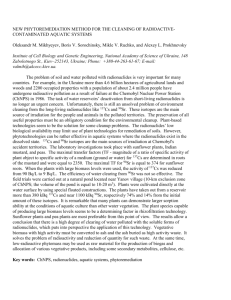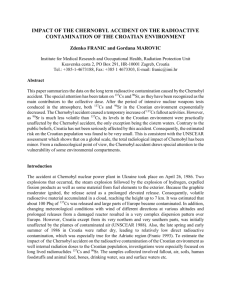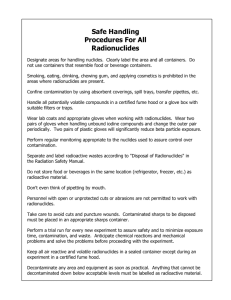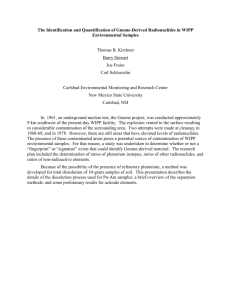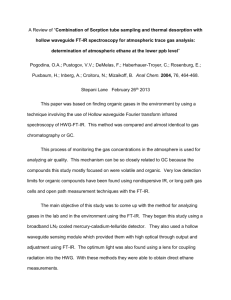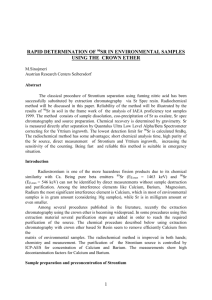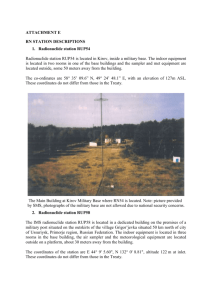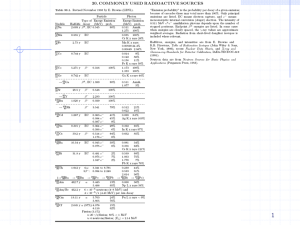Contribution to Regulatory Development
advertisement
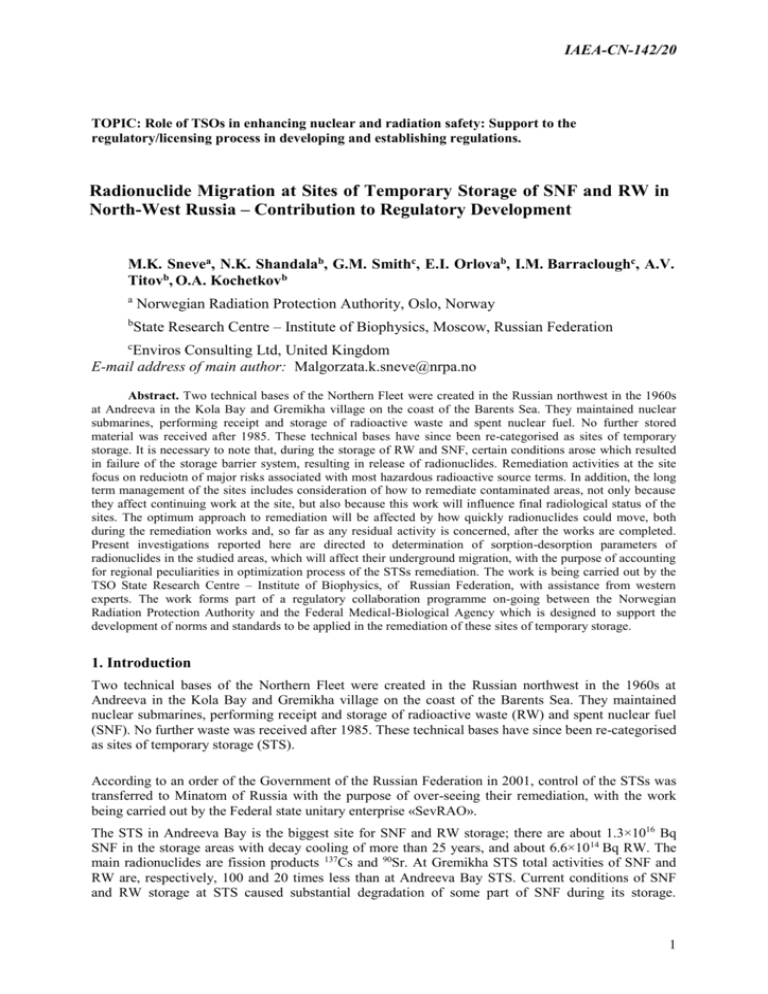
IAEA-CN-142/20 TOPIC: Role of TSOs in enhancing nuclear and radiation safety: Support to the regulatory/licensing process in developing and establishing regulations. Radionuclide Migration at Sites of Temporary Storage of SNF and RW in North-West Russia – Contribution to Regulatory Development M.K. Snevea, N.K. Shandalab, G.M. Smithc, E.I. Orlovab, I.M. Barracloughc, A.V. Titovb, O.A. Kochetkovb a b Norwegian Radiation Protection Authority, Oslo, Norway State Research Centre – Institute of Biophysics, Moscow, Russian Federation c Enviros Consulting Ltd, United Kingdom E-mail address of main author: Malgorzata.k.sneve@nrpa.no Abstract. Two technical bases of the Northern Fleet were created in the Russian northwest in the 1960s at Andreeva in the Kola Bay and Gremikha village on the coast of the Barents Sea. They maintained nuclear submarines, performing receipt and storage of radioactive waste and spent nuclear fuel. No further stored material was received after 1985. These technical bases have since been re-categorised as sites of temporary storage. It is necessary to note that, during the storage of RW and SNF, certain conditions arose which resulted in failure of the storage barrier system, resulting in release of radionuclides. Remediation activities at the site focus on reduciotn of major risks associated with most hazardous radioactive source terms. In addition, the long term management of the sites includes consideration of how to remediate contaminated areas, not only because they affect continuing work at the site, but also because this work will influence final radiological status of the sites. The optimum approach to remediation will be affected by how quickly radionuclides could move, both during the remediation works and, so far as any residual activity is concerned, after the works are completed. Present investigations reported here are directed to determination of sorption-desorption parameters of radionuclides in the studied areas, which will affect their underground migration, with the purpose of accounting for regional peculiarities in optimization process of the STSs remediation. The work is being carried out by the TSO State Research Centre – Institute of Biophysics, of Russian Federation, with assistance from western experts. The work forms part of a regulatory collaboration programme on-going between the Norwegian Radiation Protection Authority and the Federal Medical-Biological Agency which is designed to support the development of norms and standards to be applied in the remediation of these sites of temporary storage. 1. Introduction Two technical bases of the Northern Fleet were created in the Russian northwest in the 1960s at Andreeva in the Kola Bay and Gremikha village on the coast of the Barents Sea. They maintained nuclear submarines, performing receipt and storage of radioactive waste (RW) and spent nuclear fuel (SNF). No further waste was received after 1985. These technical bases have since been re-categorised as sites of temporary storage (STS). According to an order of the Government of the Russian Federation in 2001, control of the STSs was transferred to Minatom of Russia with the purpose of over-seeing their remediation, with the work being carried out by the Federal state unitary enterprise «SevRAO». The STS in Andreeva Bay is the biggest site for SNF and RW storage; there are about 1.3×1016 Bq SNF in the storage areas with decay cooling of more than 25 years, and about 6.6×10 14 Bq RW. The main radionuclides are fission products 137Сs and 90Sr. At Gremikha STS total activities of SNF and RW are, respectively, 100 and 20 times less than at Andreeva Bay STS. Current conditions of SNF and RW storage at STS caused substantial degradation of some part of SNF during its storage. 1 Moreover, considerable amount of radionuclides has already penetrated into the soil near the storage areas at the depth of few meters. Potential of this contamination spreading as well as those of other possible contaminations generates additional risks both of local and regional scale. Further description of the radiological situation of the sites is given in [1]. The studies are directed to determination of sorption – desorption parameters of radionuclides in examined units that would affect underground migration. During underground migration, radionuclides are carried from the contamination sources, along with infiltrating rainwater, to subsoil water and further to the points of discharge to the sea. The transfer of radionuclides into subsoil water is primarily defined by their entry path from contaminated soils, while the transfer of radionuclides from subsoil water into the sea depend on their sorption by rocks of the upper water-bearing horizon. 2. Material and investigation methods Experiments relating to desorption and sorption were performed in static conditions. The experimental method included periodic, short-time (2-3 min) mixing of examined sample with water over the course of a working day, and further suspension lift-off over 20 hours. The soil samples used in the desorption experiments were those which had being collected on-site at the STSs [1]. The larger part of soil was dried in air, weighed and then covered with pure natural water with very low mineralization. The ratio between solid and liquid phases was selected, within the range of 1.3 – 3.0, depending on moisture capacity of soil sample. After contact, water was separated from the soil sample and radionuclide filtrate content was determined. New portion of pure water was added to the rest of the soil and the experiment was repeated 2 or 3 times, depending on the initial sample contamination. For the prediction of radionuclide underground migration data are required of distribution factors (Kd) of nuclides between soils and filtering contaminated waters This factor is equal to the ratio of activity concentration of each of radionuclide in filtrate to equilibrium activity concentration in soil. Kd determination was implemented in static conditions. The strategy consisted of mixing of sand sample of natural mechanical content with some quota of contaminated water containing one of radionuclides, almost until equilibrium establishment. Hydrocarbonate natural water of 240 mg/l mineralization and calcium–sodium cation content was used. The ratio between solid and liquid phases was 1:2. The duration of mixing was 1-2 hours and the mixture then settled during approximately 20 hours. Decantate was separated from sand, then it was filtrated and its activity concentration was determined, while new portion of water was added to the sample and the experiment was repeated 3-5 times depending on sorption ability of sand. Three experiments were performed concurrently for each of the samples. Subsequent additions of initial solution to the sample of soil allowed, within certain degree, approximation of data obtained in static conditions to results observed in the process dynamics. The distribution factor was calculated for each of the solution additions to each sample (Kdi):- kdi Si1 (C0 Ci) V (1) Cim where: С0 – activity concentration of initial solution, Bq/cm3; Сi - activity concentration of equilibrium solution, i – addition, Bq/cm3; m – mass of sand sample, g; V – volume of initial solution, cm3; Si-1 – amount of sorbed radionuclide with sand sample in previous additions, Bq. Then Kd was determined as the mean value by all of the additions from three concurrent experiments with standard deviation at 0,95 confidence probability.. 2 3. Result and discussion The radiation situation at STS off-industrial sites territory is defined by: а) value of activity, b) mobility or immobility of contamination and 3) mechanisms and pathways for migration [2]. Migration pathways are affected by man, as well as the physical and chemical state of radioactive contamination and migration media, especially in water systems. The results of desorption studies are given in table 1 for 137Cs and 90Sr. Table 1 – Radionuclide desorption from soil by water 137 90 Cs № soil sample* 1 2 3 4 № water addition Content of soil Sr Desorption, % Kds, g/cm3 Desorption, % Kds, g/cm3 1 0.015 1.810-3 1.4 1.810-2 2 0.09 1.210-3 0.9 1.110-2 Humus with additions of sand and weathered stone 1 0.21 6.310-3 2.0 6.010-2 2 0.06 2.410-3 0.9 3.010-2 Peat with stone 1 0.40 5.510-3 3.2 4.810-2 2 0.20 2.810-3 1.2 1.810-2 1 0.10 1.110-3 Humus lightly sanded weathered Humus with small main rock of Here, 90Sr mobility, as determined by Kds, is approximately 10 times greater than that of 137Cs. Following desorption, physical-chemical states of radionuclides in filtrates were defined using ionites: KU-2-8 cationite in sodium-form and AV-17 anionite in chlorine form. Almost full absorption of 137Cs and 90Sr cationite shows that they are in a form of cations in infiltrate waters, and their spreading with subsoil waters depends on sorption processes. Radionuclides being desorbed by precipitation, during infiltration, enter to the upper water-bearing horizon where they are sorbed by water-containing rocks. According to [2], at the industrial sites of STS in Andreeva Bay, the nearest to the surface horizon is located at a depth of 1 – 2.8 m, its power (i.e. depth of water-bearing horizon) is 0.2 – 1.7 m. There are nonartesian waters, their contents is hydrocarbonate calcium-sodium. The horizon water supply is due to rainwater infiltration; into lower second water-bearing horizon. Clay soils of sea nature serve as the lower aquiclude. Sands are the main water-containing rocks, whose data on granulometric content is practically absent. The limited results obtained show tendencies expected from results elsewhere. Data for concentration profiles are available from the STSs. In cores of holes №3 and №12, slow decreasing is observed of the concentration ratio 137Cs/90Sr with depth; this serves as an evidence of high 90Sr mobility in comparison with that of 137Cs. The contents of radionuclides in the surface layer together with processes of sorption - desorption define the specific activity of radionuclides in core samples. Some sharp decreasing of 137Cs concentration (about 25 times) with core depth (0-0.5 m) in hole 2, is perhaps, due to its very low washing-out from the surface layer and to its considerable sorption by bedding ground up to 0.5 m depth. These grounds absorb 90Sr slightly. So, the ratio of specificity activities for 137Cs/90Sr in the present core at depth of 0.5 m is practically the same as that of the rest samples (0.5 m) from holes 3 and 12. 3 Thus, when considering pathways of radionuclide migration from the surface of the industrial site territory, 90Sr has to dominate in underground waters. Really, the ratio of specific activities 137Cs/90Sr in underground water from two examined holes was about 0.006. At the same time, in averaged seawater sample collected in point 12, this ratio 137Cs/90Sr equals ~ 1. Presented data on ratios of 137 Cs/90Sr in seawater confirm that contaminated territory of STS industrial site serve as a source of radionuclide intakes into coastal area of the Barents Sea. Seawater contamination may be implemented by means of two pathways a) with underground water and b) due to washing away from the soil surface. As activity ratio of Cs and Sr in seawater is similar to that measured in underground water, it could be assumed that seawater contamination is due to releases from the site. 4. Conclusion The distribution of radionuclides in the environment within and outside the STSs depends on manmade and natural conditions as well as the physical and chemical characteristics of the radioactive contamination. Measurements have been made to understand these features at the STSs including locally relevant sorption and desorption. Based on the current work, the following conclusions are made: The sorption – desorption parameters of 137Cs and 90Sr, specifying the process of radionuclide interactions with soils and weathered rocks in infiltration of precipitation and in underground flux, respectively have been determined. It was shown that 90Sr desorption is approximately an order of magnitude greater than 137Cs washing-out, while 90Sr sorption by the weathered rock is on average 26 times lower than their 137Cs absorption value. Conditions help to increase underground migration of 90Sr and its entrance into sea water of the coastal area of Motovsky bay of Andreeva and Chervyanaya Bays near Ostrovnoy and Gremikha village. Currently, the ratio concentrations of 137Cs/90Sr in the ground cores decreases gradually from 2.7 – 2.8 at the surface to 1.2 – 1.8 and 0.2 – 0.3 at a depth of 0.5 and 1 m, respectively. The ratio of concentrations 137Cs/90Sr in the ground water of the first water bearing horizon varied in the range of <(0.15 – 0.2), while in the ground water of the second water bearing horizon was ~0.006 according to data from 2004 - 2005. A lot of materials specifying flows of radionuclide underground migration are required to develop criteria and guidance for remediation of radioactive contaminated territories taking into account their impact to the radiation state of sea media. Hence, the investigation are to be continued of processes of 137Cs and 90Sr interaction with soils, grounds and bottom sediments; at the same time, content of 137Cs and 90Sr and 3Н should be determined in these units, as well as in underground and sea water. There is an opportunity to evaluate radionuclide migration abilities in natural conditions, using data on contents of 137Cs and 90Sr in cores, currently being extracted during building of new observation holes at the industrial site at Andreeva Bay. Information on the scope for radionuclide migration from the site will be used to support regulatory decisions on the suitability of proposed remediation options and deveopment of remediation criteria. ACKNOWLEDGEMENTS The work described in this paper is funded by the Norwegian Government, through a Plan of Action implemented by the Ministry of Foreign Affairs (MoFA) promoting improvements in radiation protection and nuclear safety in North-West Russia. REFERENCES [1] Ilin L, Kochetkov O, Shandala N, Savkin M, Sneve MK, Børretzen P, Jaworska A, Smith G, Barracklough I, Kruse P. Initial threat assessment: Radiological risks associated with SevRAO facilities falling within the regulatory supervision responsibilities of FMBA. StrålevernRapport 4 2005:17. Østerås: Statens strålevern (Norwegian Radiation Protection Authority), http://www.nrpa.no/dokumentarkiv/StralevernRapport17_2005.pdf (28.03.06) 2005. [2] Radiation-spectrometric examination of buildings< constructions? Samples of soil and rock ground, being obtained in boring at Andreeva bay /Report №16.1253. – Moscow: FSUE NIKIET – 2004. – 85 p. 5
